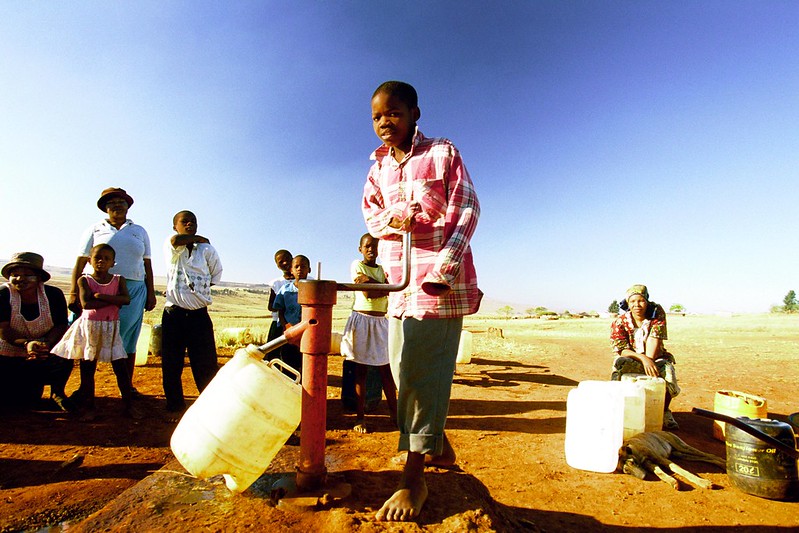South Africa’s Water Safety Issue
 South Africa’s central water infrastructure is deteriorating below acceptable levels–its negative effects threatening the health and wellbeing of the nation’s poor.
South Africa’s central water infrastructure is deteriorating below acceptable levels–its negative effects threatening the health and wellbeing of the nation’s poor.
The Hammanskraal Cholera Outbreak
In May 2023, 29 people died from contracting cholera in the region of Hammanskraal in South Africa. Cholera outbreaks have happened before in the country, but they usually occur in rural areas, not in city centers. Hammanskraal is only 20 miles away from South Africa’s capital Pretoria and is part of the Gauteng province that is known for its high level of urbanisation.
Piped water had the reputation for being the safest form of water compared to other improved water sources (public taps, protected boreholes/springs, rainwater) and surface water sources (rivers, ponds, irrigation channels) in South Africa.
The singular fact that a devastating cholera outbreak occurred in South Africa’s urban center indicated that the country’s water treatment infrastructure had deteriorated to a level that made it unreliable–signaling a scarcity of safe drinking water throughout the nation. The poor of South Africa, lacking the economic ability to access costly clean water, therefore face a serious health threat.
The Mismanaged South African Water System
The 2023 BlueDrop investigation found that 46% of the country’s water supply systems failed to prevent contamination of pathogens and bacteria. Many researchers find fault in the fact that 90% of the wastewater plants in South Africa are dysfunctional, unable to treat incoming wastewater and tragically releasing back “raw or partially treated sewage directly into the country’s already scarce water resource.”
The rural and poorest demographic relies on surface water for their drinking needs and therefore faces critical health threats. Even the demographic living in areas with piped water coverage faces similar health concerns due to the dysfunctional central water system of South Africa which has 47% of its distributed water leaking, providing opportunities for contamination, according to The Conversation. Contaminated water can lead to outbreaks of diarrheal diseases that are especially lethal to the poor demographic who has limited access to appropriate medical services.
Professor Anja du Plessis writes in The Conversation, “Reactive management, lack of political will, transparency and unaccountability over the past two decades have contributed to the current state of affairs.” Expert opinion on South Africa’s water safety crisis is that it was a preventable crisis. More than technological limits or economic incapacities, South Africa’s water issue arises from management mishandling.
The Conversation reports that 67% of workers in the water treatment facilities did not receive appropriate training. There was also a significant underinvestment of governmental funds in the repair and maintenance of the water infrastructure. Out of 257 Municipalities, 151 reported being “close to collapse.” The Conversation also reports that there were no appropriate water quality monitoring systems that alerted consumers of detected contamination in the water distribution systems.
The Solution – Decentralized Water
Decentralized water systems are water systems that are smaller in scale, delivered by non-governmental organizations and often utilize local water sources for decentralized water harvest units. While centralized water systems are an efficient way to distribute water to plenty of individuals, their massive scale and complexity require costly investments and high-level expertise within the management to facilitate the system safely.
Murendeni Mafumo, CEO of Kusini Water, notes that municipal organizations do not have the financial ability to build new infrastructures, especially considering that they are even struggling to maintain the system for 5-6 million people in urban cities. He reflects that the best way to improve the water infrastructure is “through commercial companies.”
Commercial companies like Kusini Water are utilizing the relatively low cost of decentralized water treatment units and they can be run through off-grid renewable energy to independently install water treatment plants across vulnerable communities in South Africa. The rise of decentralized water technology is enabling innovative social entrepreneurs to make a lasting impact and improve South Africa’s water safety.
Mafumo explained to AfricaX that a decentralized treatment unit that supplies 300 Households may cost around $8,000 to install. Kusini Water subsidizes its operation by establishing business deals with large companies such as Red Bull or high-income households. It offers decentralized, clean water treatment units for office buildings and corporate events and subsidizes 20 liters of water for vulnerable communities for each liter of water it sells under the deal. This effectively “trickles down money” from high-income communities to low-income communities. The company uses a 3D-printed main body and sources the filtration modules locally to lower its costs. It also creates carbon filters through local macadamia nut shells and uses its nanofibers from a local university.
Conclusion
The mismanagement of the central water system of South Africa is threatening the health of poor communities. Central water systems being very large and complex makes management difficult and building new infrastructure in water-scarce areas challenging. The development of decentralized water system technology is enabling social entrepreneurs like Kusini Water to provide clean drinking water to communities that cannot afford it, holding a bright future for gradually solving South Africa’s water safety issue.
– Siwon Kim
Siwon is based in Boston, MA, USA and focuses on Technology and Global Health for The Borgen Project.
Photo: Flickr
